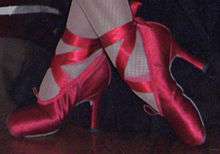Dori shoes

Dori shoes are dance shoes that combine the toe box of a pointe shoe with a dance heel approximately 3 inches ( about 7.5 cm ) in length. These allow the dancer to combine steps from multiple dance styles with classical ballet, by switching balance from standing on the heel to standing en pointe, and vice versa.[1] In 2007, Dorimar Bonilla, a Las Vegas choreographer and dancer originally from Puerto Rico, first created the shoes.[2] They were first used for performance at a cabaret show by "The Coquettes" at CatHouse, inside the Luxor Hotel and casino in Las Vegas. They have also been seen in shows such as "Ran Can Can" in Puerto Rico, "Sin City Comedy" in Las Vegas, and "Broadway Bares- Las Vegas", produced by American theater choreographer and director, Jerry Mitchell.[3]
Usage
Ballet technique is essential to many other dance styles, yet dance shoes made for styles other than ballet make performing ballet moves difficult because they do not include the support to enable dancers to perform classical ballet moves. At the same time, a traditional pointe shoe does not provide the look that most of today’s dances require. Dori shoes attempt to solve this problem and feature the toe box of a pointe shoe alongside a dance heel: this is meant to allow for multi-functional dancing and performing. The shoes are also intended to help dancers to develop a higher level of technique in their performance because dancers are not limited to a specific style. As with traditional pointe shoes, they are intended only for to be used by professional dancers onstage or students training in dance schools, not as a fashion accessory.
Construction
Dori shoes contain a specially designed sole, to allow the combination of a fully functional pointe shoe's toe box with a dance heel. This sole is flexible so that the dancer can flex or point the feet. The heel is approximately 3 in (7.6 cm). The exterior is covered with satin and it has a similar look to a traditional pointe shoe. As with traditional pointe shoes, elastic bands and ribbons must be attached to secure the shoe to the feet. The placement of elastic bands and ribbons varies depending on the physique of the dancer. For this reason, they can not be attached in the manufacturing process and instead must be attached by the dancer.
References
- ↑ Womack, Jeremy. "Dori Shoes- Pointes & Heels Dancer Shoe". Jeremy Womack.
- ↑ Womack, Jeremy. "Dori Shoes: Pointes and Heels". Las Vegas Nightlife Network.
- ↑ Leach, Robin. "Strip Scribbles". Retrieved May 24, 2010.
- Barringer, Janice; Schlesinger, Sarah (2004) [1998]. The Pointe Book (2nd ed.). Princeton Book Company, Publishers. ISBN 0-87127-261-X.
- Woodman, Xania (January 2008). "Beyond The Rope". Las Vegas Weekly Magazine.
- Sanchez, Antonio (February 2011). "El Circo de La Mega". La Mega 106.9.
- Avilés, Maricarmen- WAPA TV (February 2011). "Entre Nosotras". http://www.wapa.tv. External link in
|publisher=(help) - "Dori Shoes". http://www.Dorishoes.com. External link in
|publisher=(help)
External links
| Wikimedia Commons has media related to Pointe shoes. |